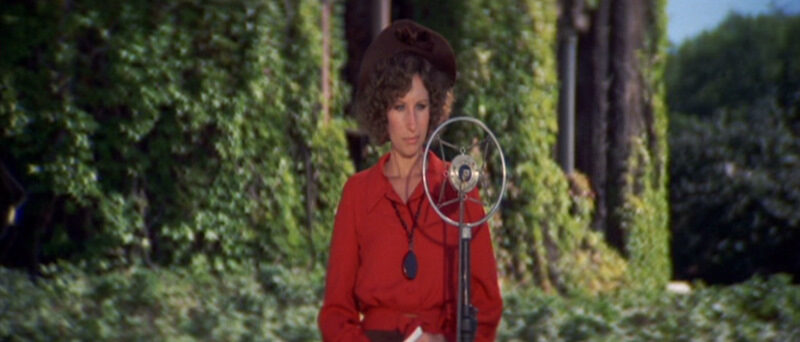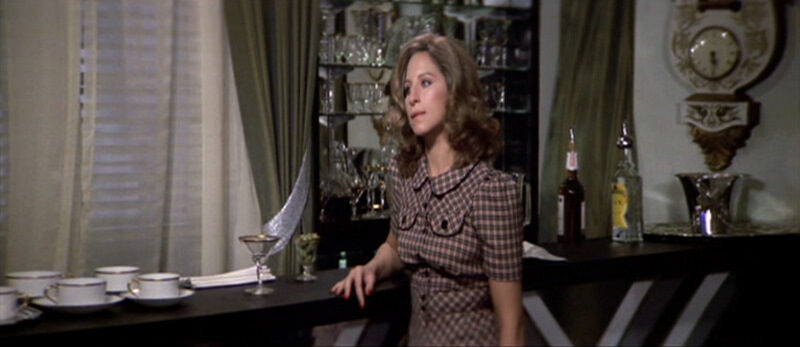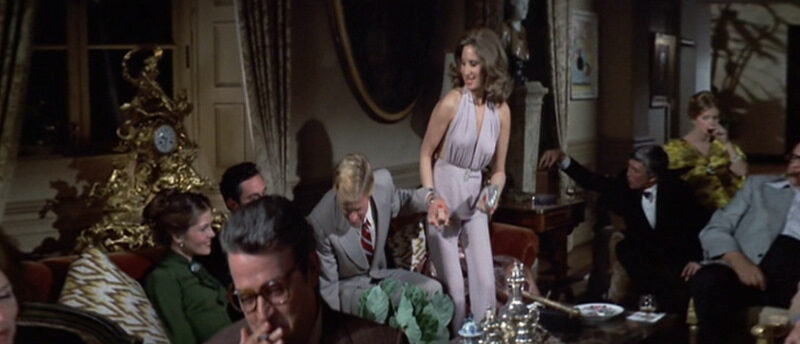Barbra Streisand in The Way We Were: Forties Meets Seventies |
 © 2011, Clothes on Film 16 May ’11
© 2011, Clothes on Film 16 May ’11
Throughout The Way We Were (1973, directed by Sydney Pollack), Barbra Streisand wears a mix of period authenticity and contemporary fashion, as costumed by Dorothy Jeakins and Moss Mabry. Essentially she is dressed as Barbra Streisand. Scan photographs and footage of Barbra from the time and it is evident that the actress brought more than just herself to the project; she brought her image too.
The previous year, Barbra Streisand had experimented with the wilder excess of seventies trends in What’s Up, Doc? with Ryan O’Neal. Although now fondly remembered for upping her ‘cute’ contingent, What’s Up, Doc? was a mere flash in the pan. Streisand was never playful or cute; she was feisty and striving elegance. The Way We Were can seem like an elevated representation of this persona onscreen.
After an introductory prologue, the narrative begins proper in college, probably mid-1930s, Barbra Streisand playing Katie Morosky, dressed in searing bright red while lecturing fellow students about Marxism. Her wild curly locks, presumably in place to signify Katie’s transition to desirable later in the story, is reminiscent of the outrageous perm Streisand revisited in 1976 after an equally shocking cropped hairpeice worn (requested) for For Pete’s Sake two years prior.
When the timeline zips ahead to World War II, Katie now in love with the man who tried to woo her with little success at college, Hubbell Gardiner (Robert Redford), most of Barbra’s look is centred on 1940s tea dresses, with mild colour blocking and inverted pleat jackets. The longer line skirt, wide collar points, Western style patch pockets and high heel court shoes, plus continued love for a Peter Pan neckline, are also indicative of the 1970s rejection of teeny shifts and PVC boots.
During the ‘falling in love’ montage, Streisand noticeably wears a red ring on her finger and then a red dress with matching shrug. Throughout the story she blatantly displays red painted nails – spiky reminders of Katie’s revolutionist tendencies. Streisand has always been very proud of her long, slender fingers. When an under-the-counter pornography film surfaced, apparently featuring her in all manner of sexual scenarios, Barbra checked out the footage first hand, proclaiming “There they were: short, stubby fingers! Definitely not mine… don’t waste your money”.
As The Way We Were moves ahead to Los Angeles, Katie and Hubbell now an outwardly happy couple; him a screenwriter, her playing housewife, there is an obvious change in era to the 1950s. Here Barbra Streisand partakes in a kind of pseudo-futuristic fashion show. In effect she, or Jeakins and Mabry, predict her own off-screen style for the next 2-3 years.
Streisand’s first outfits during Act 2 are a white flared pant suit (a look repeated for several off-screen concerts) worn with lilac vest, followed by purple and mauve patterned short sleeve blouse and flared slacks for the beach. American designer Claire McCardell came to prominence during the 1940s for originating a classic but relaxed style, often featuring gingham, front buttoned cotton dresses and wide leg or ‘Arabian’ trouser suits. On close inspection, Barbra is wearing flares, fitted through the thigh then kicked out from the knee. Redford’s equally well-groomed Hubbell endorses the look in a flared single breasted suit, wide collared shirt and brown patent leather loafers.
There is a paradox concerning Barbra Streisand in The Way We Were, in that she is dressed in costume that influences her own personal style, yet to some degree is already based upon it. Towards the end of the film she is back in padded shouldered dresses, before moving onto her own signature empire line style, on this occasion primarily lightweight tunic tops. That she is pregnant provides narrative justification, but even so it is a shape we are inherently familiar with; so much so it follows a shorthand silhouette for the actress that she may never escape from.
The final scene presents possibly Streisand’s most familiar real life look, from the early 1970s anyway, with corresponding bubble perm. She wears a flared camel coat and brown rollneck sweater. This is a style icon cementing her place in sartorial history.
Knowing the discipline Barbra Streisand has always exerted over her image, it is quite possible she instigated control over her ‘look’ in the film. As with Cary Grant, who in early days had supply his own costumes and was trusted to do so, with Barbra Streisand there is sometimes little differentaion from costume, at least in the more contemporary sense, and clothes.
© 2011 – 2012, Chris Laverty.








